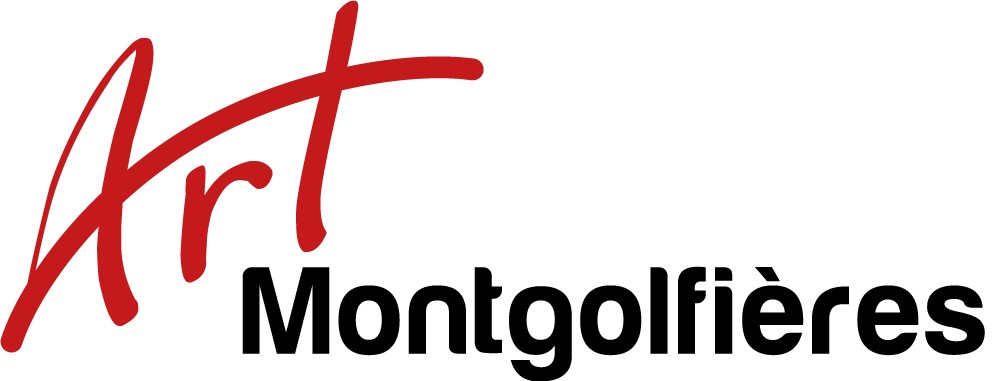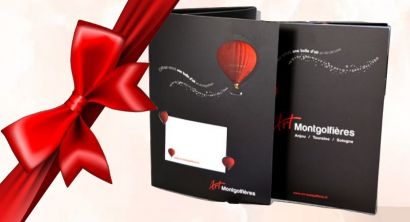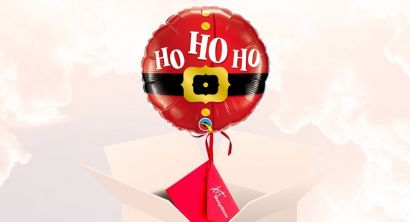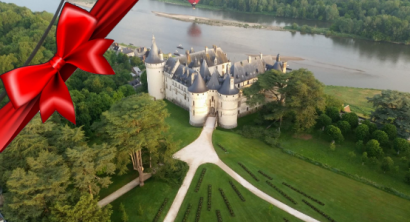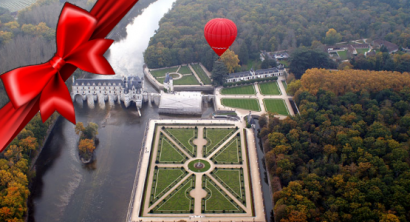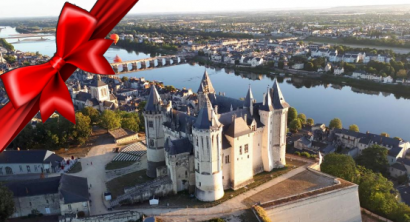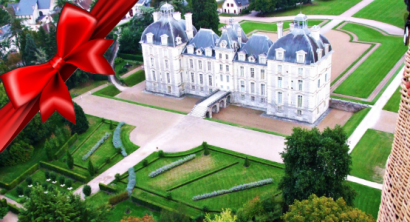No products
- I have my tickets
- The world of ballooning
- Useful information
- 02 54 32 08 11
Christmas promotional offers with a hot-air balloon flight
HO HO HO!
The whole team wishes you happy Christmas !
It's the perfect time to enjoy the scent of the tree, the light of candles and, above all, the joy of being with family.
This year, we wish you an Advent season like the old days, with no pre-Christmas stress, no useless or hastily-chosen gifts. We wish you lots of love and wonderful memories. Every moment spent with loved ones is essential to our fulfillment and happiness. Christmas is a wonderful opportunity to show you how much we care. We are grateful for your support over the years. We are happy to share some of your dreams and wonderful moments. That's why we're pleased to offer you below great discounts for Christmas (you can take advantage of promotional offers now to fly during the flying season, from the beginning of April to the end of October next) and at the end of the page these few words to discover a little about the origins of the holidays.
A wonderful family celebration
More than ever, Christmas festivities are a time for family gatherings. For many, these festivities retain a strong religious interpretation around which to gather and share. For many others, the festivities are disconnected from the religious interpretation and gradually take on a secular character, but remain an opportunity for family reunion. Today, the ritual of the festive season is unanimously embraced, and all over the world, the spirit of Christmas is the perfect excuse to see loved ones. These days, life is a whirlwind of daily routines, children and work. Time flies by at breakneck speed, but at Christmas the magic takes over and slows it down to let us enjoy the essentials, the people we love.
The Christmas songs
Families lucky enough to have a musician in their midst have the chance to play a few classics. Whether you're a music lover or a Sunday singer, the emotion is always there when you sing from the heart. Since the 14th century, Christmas carols have been considered a form of popular religious song. If carols began to become popular and a particularly common genre in the 19th century, it was with the publication of music books devoted to Christmas carols. And it was in Britain that another Christmas custom emerged: in Victorian times, it involved visiting homes to sing carols. It was called "Carols on Your Doorstep". Today, singers such as Maria Carey are reaching download heights with their special Christmas songs, and have replaced the old street choirs. But music remains an essential part of every important moment in our lives, and particularly so at the festive season.
Comforting sweets
Want to know one of our other holiday staples? Our stomachs, of course! Christmas Eve is the festive meal on Christmas Eve, with different traditional specialties in different countries, but the main course is usually a stuffed goose or turkey, not forgetting the good mashed potatoes that go with it, which must be homemade. As for desserts, each country or region has its own speciality: in France, it's often a Yule log. The famous little log-shaped dessert is most often a rolled cake covered in chocolate cream, sometimes an ice cream. This log recalls the ancient tradition of putting a large log on the fire at the start of the eve. This log was chosen for its size and quality, as it was to burn throughout the vigil. In Provence hot-air balloon flight, the tradition is to end the meal with thirteen different desserts, including candied fruit, fresh fruit, sweets, almond paste and dried fruit. In Britain, the dessert is prepared well in advance, several weeks in advance. Christmas pudding is served flambéed. Folklore has it that barley sugars first appeared in Germany in 1670, when the choirmaster of Cologne Cathedral distributed them to children to keep them quiet during worship. He then asked the confectioner to make them in the shape of a shepherd's crook, in memory of the shepherds who came to adore the infant Jesus. Another delicacy for many on the other side of the Atlantic is the famous eggnog. It's a drink rarely consumed in France, but very popular in the United States. The recipe is simple: milk, cream, sugar, beaten eggs, alcohol (brandy, cognac, rum, sherry, whisky) and sometimes spices like cinnamon or nutmeg. Food historians believe it derives from the British "posset" of the early Middle Ages, a warm, milky, ale-like drink. As milk and eggs were common staples in the American colonies, eggnog became a popular drink at festive times.
The Christmas cards
Another British tradition is the Christmas card. It was first sold in London in 1843. Mr. Henry Cole, too busy to write letters of greeting, asked an artist friend to design a card with a picture and a brief greeting that he could send by post. The artist, John Callcott Horsley, printed 1,000 greeting cards and sold them for 1 shilling* each at Summerly's Treasure House in London. Americans imported greeting cards until 1875, when a German emigrant named Louis Prang, "the father of the American Christmas card", created the first series of Christmas cards marketed in the USA.
The Christmas Socks
The origin of the stockings hanging on the chimney is uncertain. A popular legend has it that Santa Claus heard of a family who were very poor, but too proud to accept charity. The father, recently widowed, could not provide a dowry for his three daughters. So Santa threw a few gold coins down the chimney. They fell into the girls' stockings, which were hung up to dry. Another version has it that Santa left three golden balls (originally an offering of oranges or tangerines).
While in the 19th century stockings, now replaced by decorated Christmas socks, were the most emblematic of the holiday, the German Christmas tree has become a must-have in our homes.
What's certain is that Christmas really takes hold in our homes with the appearance of Christmas decorations. Whether indoors or out on the streets, they create a real festive atmosphere. They look best when they're brightly lit, so they can be lit as soon as night falls.
The Christmas illuminations
Since the beginning of Christianity, on Christmas Eve, a large candle symbolizing Christ and his light on the world is lit and burns throughout the night of the Nativity.
In the 17th and 18th centuries, Christmas trees were lit with 12 candles, each representing a month of the year. As candles were very expensive, they could be replaced by flexible candles tied around the branches or walnut shells filled with oil and wick.
The very first electric garland was developed by Edward Hibberd Johnson, a close friend of Thomas Edison, in 1822.
Today, many towns and villages organize illuminations competitions and other light shows.
The Christmas tree
Santa Claus places his presents at the foot of the Christmas tree. The tradition of a decorated tree goes back a long way, since the Celts decorated a tree as a symbol of life at the time of the winter solstice. The Scandinavians did the same for the festival of Jul, which took place around the same time as Christmas.
The decorated Christmas tree as we know it today is thought to have appeared in Germany in the 15th century and in Alsace in 1521. The first Christmas trees were called "paradises" in reference to the "trees of paradise". They were decorated with scenes from the feast of Adam and Eve. Round host-shaped pastries symbolizing the Eucharist were often hung on them, along with apples, nuts, candies or colored paper, ribbons or metal bangs inspired by the military braids that have become our angel hair. This gave rise to the fir-shaped baubles and cookies that decorate the Christmas tree in Germany. Since conifers were the most common type of tree in the East, and that's where the tradition came from, the fir became the tree to have.
Once considered a pagan practice by the Catholic Church, it wasn't until the mid-20th century that it accepted the installation of this tree in homes.
Advent calendars
Advent means "arrival, coming". It's the period 4 weeks before Christmas Eve and the preparation for the coming of Christ and the beginning of the liturgical year. During this period, Christians imposed a fast on themselves and prepared the feast, the meal, cleaned and decorated the house.
Today, Advent comprises the four Sundays before Christmas, although most Advent calendars start on December 1 and mark the 24 days leading up to Christmas. The tradition dates back to the mid-19th century, when German Protestants marked doors with chalk or lit candles to count the number of days remaining until Christmas. The first printed Advent calendar was produced in the early 1900s by a German named Gerald Lang. As a child, his mother sewed 24 cookies onto the lid of a box and allowed her son to eat one a day during Advent. Mr Lang used this as the model for his own Advent calendar.
The gifts
Many legends are used to make children dream about where the presents under the tree come from. In France, the baby Jesus was said to bring them. In Italy, the witch Befana brought gifts and sweets to well-behaved children, but lumps of coal to the less well-behaved. In some regions, Saint Nicholas is accompanied by Père Fouettard, who is responsible for punishing the less well-behaved.
Today, the most common image worldwide is that of Santa Claus. According to legend, he's an old man who travels around the world in a sleigh pulled by reindeer on the night of December 24-25 (Christmas Eve). He slips down chimneys to bring gifts to children all over the world, carrying them in his sack. Inspired by the image of Saint Nicholas, he wears a big red coat, formerly green, and a big white beard. This representation of Santa Claus has become very popular around the world since the Coca Cola advertisement.
Christmas gifts are the presents we exchange on Christmas Day with those gathered under the same roof, and in the days that follow with family and close friends. Whether they're opened on Christmas morning or at the end of Christmas Eve, and whether they're intended for children or adults, these gifts are above all a foretaste of sharing and happiness with the people we love.
We wish you all the best for the New Year! And a very Merry Christmas!
DISCOVER OUR OFFERS, CLICK HERE
